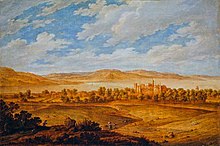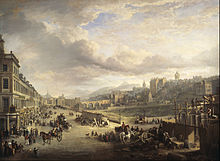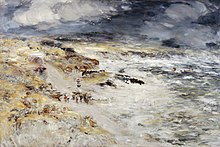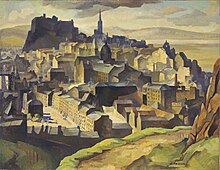Landscape painting in Scotland
The capriccios of Italian and Dutch landscapes undertaken as house decoration by James Norie and his sons in the eighteenth century brought the influence of French artists such as Claude Lorrain and Nicolas Poussin.In the Victorian era, the tradition of Highland landscape painting was continued by figures such as Horatio McCulloch, Joseph Farquharson and William McTaggart, described as the "Scottish Impressionist".In the post-war period the English-born Joan Eardley explored the landscapes of the Kincardineshire coast and created depictions of Glasgow tenements and children in the streets.Husband and wife Tom MacDonald and Bet Low with William Senior formed the Clyde Group, aimed at promoting political art and producing industrial landscapes.Norie, with his sons James (1711–36) and Robert (d. 1766), painted the houses of the peerage with capriccios or pastiches of Italian and Dutch landscapes,[7] bringing to Scotland the influence of French artists such as Claude Lorrain and Nicolas Poussin.[7] More's series of four paintings "Falls of Clyde" (1771–73), produced before his departure to Italy, have been described by art historian Duncan Macmillan as treating the waterfalls as "a kind of natural national monument" and has been seen as an early work in developing a romantic sensibility to the Scottish landscape.[9] Highly influential in this process was the Scottish philosopher Archibald Alison's Nature and Principles of Taste (1790), which widened the forms of landscape seen as appropriate for painting, placing an emphasis on their historical significance and emotional impact on the painter.[10] Paul Sandby (1731–1809), often considered the "father of British watercolour painting",[11] visited Scotland as part of the military survey that followed the 1745 Jacobite rebellion and undertook a number of studies of Scottish scenes.[20] Towards the end of his career he undertook panoramic works of the views from the top of Ben Lomond, which played a part in opening up the Highlands as a spectacle that would be taken up by artists in the second half of the century.[24] In this period a Scottish "grand tour" developed with large number of English artists, including Turner, flocking to the Highlands to paint and draw.[23] From the 1870s Farquharson was a major figure in interpreting Scottish landscapes, specialising in snowscapes and sheep, and using a mobile heated studio in order to capture the conditions from life.[25] The fashion for coastal painting in the later nineteenth century led to the establishment of artist colonies in places such as Pittenweem and Crail in Fife,[26] Cockburnspath in the Borders, Cambuskenneth near Stirling on the River Forth[27] and Kirkcudbright in Dumfries and Galloway.All had spent time in France between 1900 and 1914[30] and all looked for inspiration to Paris, particularly to the Fauvists, such as Monet, Matisse and Cézanne, whose techniques they combined with the painting traditions of Scotland.John Duncan, the arts and crafts artist, was still active in the early twentieth century and painted several landscapes similar in style to those of Cadell and Peploe.[34] Leading architect Charles Rennie Mackintosh (1868–1928) abandoned architecture for painting after World War I and created a number of landscapes, particularly of southern France.






Horatio McCullochpainting of landscapesScottish house decorationAlexander KeirincxCharles IcapricciosClaude LorrainNicolas PoussinJacob MorePaul SandbyAlexander RuncimanAlexander NasmythAndrew WilsonHugh William WilliamsJoseph FarquharsonWilliam McTaggartPittenweemScottish ColouristsJohn Duncan FergussonFrancis CadellSamuel PeploeLeslie HunterEdinburgh College of Artthe Edinburgh SchoolSt. Ives SchoolWilliam GilliesJohn MaxwellWilliam CrozierWilliam MacTaggartScottish RenaissanceStanley CursiterCeltic revivalPost-ImpressionismFuturismJames McIntosh PatrickEdward BairdBruegelJoan EardleyKincardineshireWilhelmina Barns-GrahamMargaret MellisBet LowClyde GroupJohn BellanyJoyce W. CairnsScottish art in the eighteenth centuryReformationSkelmorlie AisleSeton HouseWilliam AdampastichesPerthshireBlair CastleDuncan MacmillanromanticArchibald Alison1745 Jacobite rebellionwatercoloursPrinces Street with the Commencement of the Building of the Royal InstitutionRobert BurnsScottish art in the nineteenth centuryWalter ScottTrossachsThe Lady of the LakeBen LomondVictorian eraGlen CoeLoch LomondBalmoralEdwin LandseerMonarch of the GlenTurnerJohn ConstableCockburnspathCambuskennethKirkcudbrightGlasgow BoysW. Y. MacgregorJames GuthrieJohn LaveryGeorge HenryE. A. WaltonArt in modern ScotlandFauvistsMatisseCézanneBen MoreJohn DuncanBallochCharles Rennie MackintoshDavid Young CameronArdnamurchanabstractionGlasgow School of ArtrealistJosef HermanDuncan ShanksBarbara RaePortrait painting in ScotlandWayback MachineScottish artPrehistoricInsular artMedievalEarly modernEighteenth centuryNineteenth centuryModernCeltic broochGenre artPhotographyPortraitureSculptureRenaissanceEnlightenmentRomanticismPre-RaphaelitesArts and CraftsCeltic artGlasgow SchoolEdinburgh SchoolNew Scottish GroupAberdeenDundeeEdinburghGlasgow